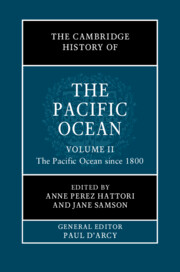Book contents
- The Cambridge History of the Pacific Ocean
- The Cambridge History of the Pacific Ocean
- The Cambridge History of the Pacific Ocean
- Copyright page
- Contents
- Figures
- Tables
- Contributors to Volume II
- Frontispiece
- General Editor’s Introduction
- Preface to Volume II
- Part VII Rethinking the Pacific
- Part VIII Approaches, Sources, and Subaltern Histories of the Modern Pacific
- Part IX Culture Contact and the Impact of Pre-colonial European Influences
- 44 The Pacific in the Age of Revolutions
- 45 Disease in Pacific History
- 46 The Culture Concept and Christian Missions in the Pacific
- 47 Trading Nature in the Pacific
- 48 Seaborne Ethnography to the Science of Race, 1521–1850
- Part X The Colonial Era in the Pacific
- Part XI The Pacific Century?
- Part XII Pacific Futures
- References to Volume II
- Index
47 - Trading Nature in the Pacific
Ecological Exchange prior to 1900
from Part IX - Culture Contact and the Impact of Pre-colonial European Influences
Published online by Cambridge University Press: 11 November 2022
- The Cambridge History of the Pacific Ocean
- The Cambridge History of the Pacific Ocean
- The Cambridge History of the Pacific Ocean
- Copyright page
- Contents
- Figures
- Tables
- Contributors to Volume II
- Frontispiece
- General Editor’s Introduction
- Preface to Volume II
- Part VII Rethinking the Pacific
- Part VIII Approaches, Sources, and Subaltern Histories of the Modern Pacific
- Part IX Culture Contact and the Impact of Pre-colonial European Influences
- 44 The Pacific in the Age of Revolutions
- 45 Disease in Pacific History
- 46 The Culture Concept and Christian Missions in the Pacific
- 47 Trading Nature in the Pacific
- 48 Seaborne Ethnography to the Science of Race, 1521–1850
- Part X The Colonial Era in the Pacific
- Part XI The Pacific Century?
- Part XII Pacific Futures
- References to Volume II
- Index
Summary
The title of this chapter echoes Jennifer Newell’s superb monograph, Trading Nature: Tahitians, Europeans, and Ecological Exchange, which examines a set of environmental relationships unique to Tahiti but also global in nature.1 Tahiti, in this way, reveals the ecological shifts, species invasions, and biological effects of many places around the world during the era of European imperialism in the late eighteenth and early nineteenth centuries. Newell’s work explores unique features for the study of Tahiti, and, more broadly, for Pacific scholars interested in the ‘wide ranging impacts’ of ecological exchange.2 Those features include the circumstance of Cook, Wallis, and Bougainville each ‘discovering’ Tahiti within a three-year period (1767–9), as well as the unparalleled archive of documents they generated about the islands and the Islanders themselves. A second feature transpired two decades later, when Captain Bligh led the archetypal expedition in ecological transplantation by successfully bringing Tahiti’s breadfruit trees around the world to Britain’s slave colonies in the West Indies. Paradise found, paradise transplanted. And yet the most compelling feature in Trading Nature may not be those items transported from Tahiti but instead those things introduced to the islands: plants, animals, birds, and bacteria from all points of the globe. In short, an assortment of the world’s biomatter arrived at the Society Islands, initially in the canoes of Indigenous voyagers and later under the aegis of European ventures.
- Type
- Chapter
- Information
- The Cambridge History of the Pacific Ocean , pp. 369 - 388Publisher: Cambridge University PressPrint publication year: 2023

